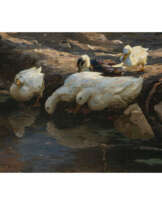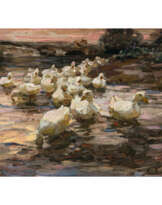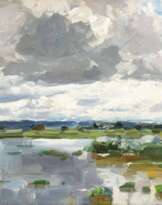ID 842666
Lot 835 | Alexander Max Koester
Valeur estimée
€ 20 000 – 25 000
Title: "Im Herbstgrase".
Flock of Ducks on the Shore.
Technique: Oil on canvas.
Measurement: 62 x 77,5cm.
Notation: Signed lower right: A. Koester.
Frame: Framed.
Verso:
Inscribed on frame and stretcher: "Im Herbstgrase. Alexander Koester. Klausen Tyrol".
Provenance:
Private ownership, Germany
When Impressionism began to develop, the genre of historical subjects in painting was in decline. The new trend in art turned more and more to the depiction of contemporary subjects, such as pubs, railway stations, views of stands and scenes from private and social life. The subjects that were to become dominant from then on tended to derive from bourgeois society and went hand in hand with the development of the leisure activities of wealthy citizens. Examples of this are the parties on the banks of the Seine painted by Renoir and Monet or bathing in Parisian suburbs. The impressionists were simply not interested in work and the social dimension it touched. One of the most important representatives of the German counterpart of the movement was the painter Alexander Koester. His oeuvre is as multifaceted as that of his French colleagues.
Nevertheless, when the name "Koester" is mentioned, images of a wide variety of ducks, painted in a light and airy manner, appear in one's mind. This fusion, so emblematic of his personal style, was celebrated by the German Impressionist especially in recent times. Koester painted his duck subjects in a wide range of variations that delighted the artist's audience even during his lifetime. The surface of the water in combination with the refraction of light and its reflections repeatedly tempted Koester to put his artistic skills to the test and to perfect them - and yet he never tired of this subject. Initially striving to depict landscapes, their true moods in the interplay of the respective daylight and the fleetingness of the moment, Koester arrived at his henceforth new favourite motif: ducks.
The present painting can be placed in the canon of the impressionist's most important depictions. He shows us six ducks seeking closeness to each other in a loving manner. The heads of the individual ducks touch lightly. They are surrounded by various flowers that softly frame the flock. The airy and impasto application of paint, so characteristic of the Impressionist period, speaks clearly again from the present painting: the ducks' plumage shines with three-dimensionality and depth; the flowers stand out through their colourfulness and impasto application. The soft source of light that seems to come from the upper right corner of the painting enhances the intimate almost familiar moment of the flock of ducks.
Koester's depictions of ducks radiate purity and tranquillity. They ask the viewer to pause and, during the viewing process, kindle a longing for times past - times when man was more in tune with the primal - nature.
Even then, his idyllic paintings formed a counter-design, namely to that of Industrialisation. Contrary to what one might think, they have not lost any of their relevance today - on the contrary: in times of digitalisation, in which there is almost constant talk of "process optimisation" of all kinds; in times that scream higher, further, better, Koester's ducks offer a place of happy being. They allow the viewer to escape, grant a place where one may turn inwards and form a counterweight to the driven attitude of our accelerated society. Precisely for this reason, his duck subjects gain even more greatness in their art-historical significance than ever before.
| Artiste: | Alexander Koester (1864 - 1932) |
|---|---|
| Technique appliquée: | Huile |
| Catégorie maison de vente aux enchères: | Peinture 19ème siècle |
| Artiste: | Alexander Koester (1864 - 1932) |
|---|---|
| Technique appliquée: | Huile |
| Catégorie maison de vente aux enchères: | Peinture 19ème siècle |
| Adresse de l'enchère |
VAN HAM Kunstauktionen GmbH Hitzelerstr. 2 50968 Köln Allemagne | ||||||||||||||
|---|---|---|---|---|---|---|---|---|---|---|---|---|---|---|---|
| Aperçu |
| ||||||||||||||
| Téléphone | +49 221 92586215 | ||||||||||||||
| Fax | +49 221 92 58 62 4 | ||||||||||||||
| Commission | 32% | ||||||||||||||
| Conditions d'utilisation | Conditions d'utilisation | ||||||||||||||
| Heures d'ouverture | Heures d'ouverture
|














